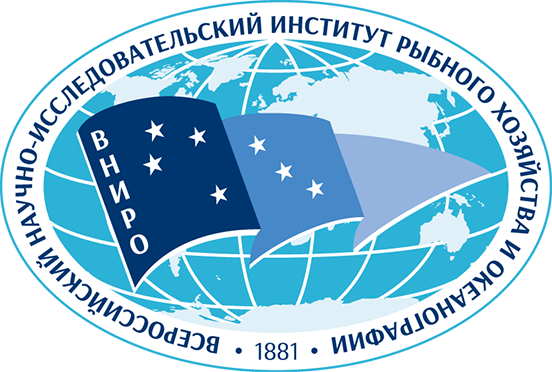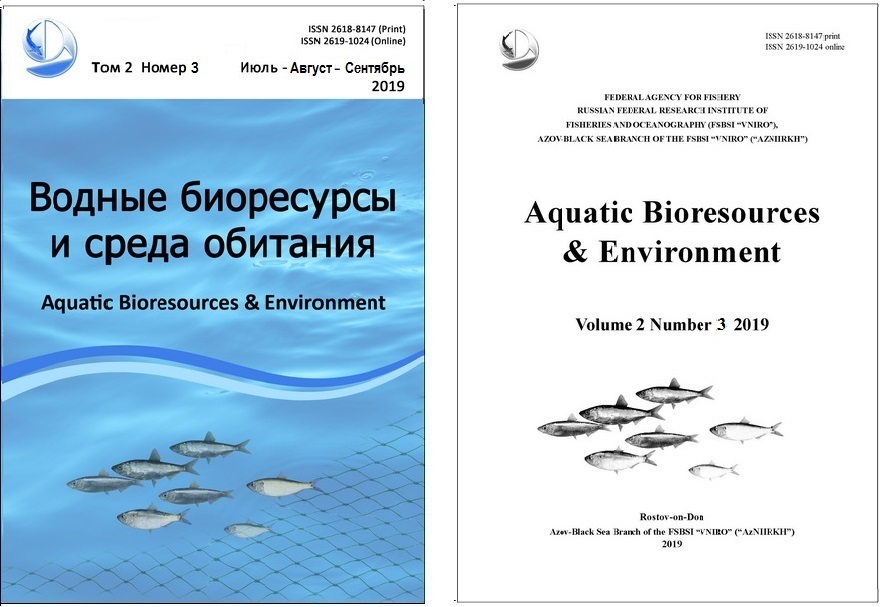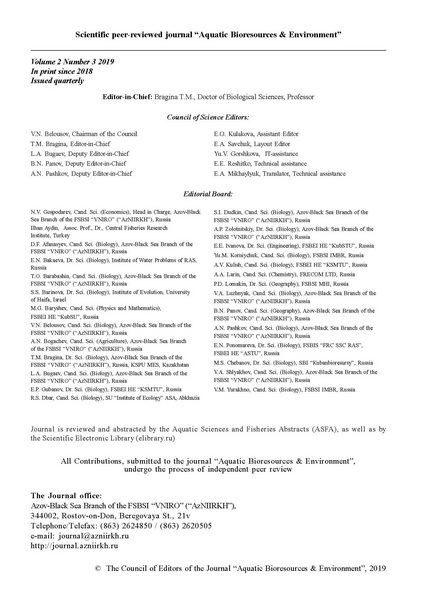Review Articles
Environmental Concerns and the State of the Aquatic Environment
Results of marine scientific research of the Southern Scientific Centre of the Russian Academy of Sciences (SSC RAS) in the Sea of Azov in 2003–2018. Part 1: Hydrology and hydrochemistry.
Berdnikov S.V., Kleshchenkov А.V., Grigorenko K.S., Oleinikov E.P., Moskovets A.Yu., Dashkevich L.V., Kulygin V.V., Sorokina V.V., Soier V.G.
Abstract. The results of analysis of long-term expeditionary research of the SSC RAS (the Southern Scientific Centre of the Russian Academy of Sciences), focused on the Sea of Azov and the oceanographic database of the SSC RAS (thermohaline structure, water transparency, hydrochemical parameters) are summarized and presented. It is noted that the distribution of isotherms on maps dated 1962–2008 shows an increase in the area of “warm” fields for the winter and spring seasons and an increase in the area of “cold” fields for the autumn one. The same trend is also maintained when comparing annual water temperature curves for the Taganrog Bay and the central part of the sea. The long-term average annual vertical oceanographic sections along the line running through the deepest part of the Sea of Azov from the mouth of the Don River to the Kerch Strait with a total length of 350 km are presented. It is noted that, under conditions of unsteady runoff, a change in frontogenesis occurs in the Taganrog Bay. Thus, an increase in the flow of the Don River in 2018 up to the level typical for the period 2001– 2005 led to the intensified formation of fronts in the Taganrog Bay. The water salinity throughout the bay has decreased, however, the values of the maxima in the western and eastern regions increased. The cases of inflow of the waters with higher salinity into the mouth of the seashore and into the arms of the Don Delta are recorded. Based on the information concerning Secchi disk depth (the depth of visibility of a white disk), which characterizes the relative transparency of water, four main types of seasonal variability of relative transparency of the Azov waters were identified, and all four types were found out to have similar features with phytoplankton dynamics. On the basis of the expeditionary observations of the SSC RAS in 2007–2018, seasonal dynamics and spatial differences in the concentrations of dissolved organic carbon in the waters of the Lower Don, the Taganrog Bay, the Sea of Azov and the northeastern part of the Black Sea are shown. It is noted that high values and increased variability of concentrations of organic carbon from the Don and Azov waters are the result of intrabasin life processes, including intensive production of microalgae, their consumption by consumers, and active bacterial processing of dead organisms with accumulation of organic matter in the water.
Keywords: Sea of Azov, water temperature, salinity, water transparency, oxygen regime, organic carbon, river runoff.
Biology and Ecology of Aquatic Organisms
Accumulation of priority pollutants in the fish of the Azov Sea over the last decade.
Korotkova L.I., Korablina I.V., Barabashin T.O.
Abstract. Results of long-term studies on the accumulation of organochlorine pesticides (OCP), polychlorinated biphenyls (PCB), heavy metals and arsenic in muscles, liver and gonads of the main commercial fish species of the Azov Sea (round goby Neogobius melanostomus, zander Sander lucioperca, so-iuy mullet Planiliza haematocheila, roach Rutilus heckelii, and anchovy Engraulis encrasicholus) are presented for the period from 2009 to 2018. Evaluation of OCP, PCB, heavy metals and arsenic was carried out in accordance with the techniques developed in the Azov-Black Sea Branch of the FSBSI “VNIRO” (“AzNIIRKH”). Out of the organochlorine pesticides under investigation, only the breakdown products of dichlorodiphenyltrichloroethane (DDT), such as dichlorodiphenyldichloroethylene (DDE) and dichlorodiphenyldichloroethane (DDD), were found in the samples; the DDT was not detected. The content of hexachlorocyclohexane isomers (α-, γ-, β-HCH) in the total amount of OCP was either below the limit of determination, or insignificant (2–3 %). Out of congeners of polychlorinated biphenyls in the organs of the investigated fish, persistent and dangerous penta-, hexa- and heptachlorobiphenyls were present in different variations, among which dioxin-like congeners were found. The concentrations of OCP and PCB found in the organs of commercial fishes did not exceed the allowable levels (AL) provided by Sanitary Rules and Norms (SanPiN). Accumulation levels of heavy metals and arsenic were low, aside from isolated cases when allowable levels were exceeded.
Keywords: Azov Sea, commercial species, organochlorine pesticides, polychlorinated biphenyls, heavy metals, arsenic.
Current state of zooplankton in the Kondopoga Bay of Onego Lake.
Syarki M.T., Fomina Yu.Yu.
Abstract. The transformation of the ecosystem in the Kondopoga Bay of Onego Lake occurred as a result of the long-term anthropogenic influence of the pulp and paper mill wastewater discharge. Wastewater enters the upper part of the bay and then, with distance, it dilutes, so its effect on plankton decreases in the central and open parts of the bay. The monitoring using zooplankton indicators makes possible to assess the current state of the pelagic system in the bay, its spatial and temporal distribution, and its response to the decrease of anthropogenic pressure. The current state of zooplankton in different parts of the bay has been assessed. Zooplankton was sampled in August of 2017, using plankton nets; the sampling was conducted at five stations, unequally distanced from the location of wastewater discharge. The species composition of the zooplankton community was stable and has not changed since the 1960s. The regularities in zooplankton spatial distribution, associated with anthropogenic eutrophication, have persisted. The zooplankton abundance was the highest in the upper part of the bay (50,000 ind./m3 and 1.5 g/m3) and, as expected, gradually decreased along the bay down to its open part (4,500 ind./m3 and 0.12 g/m3). A criterion for the anthropogenic load intensity is proposed; as such, the ratio of quantitative zooplankton characteristics from the upper and central parts of the bay can be used. In the recent decades, the decrease in the volume of wastewater has led to stabilization of the pelagic zooplankton state in the Kondopoga Bay.
Keywords: anthropogenic pressure, eutrophication, wastewater pollution, pulp and paper industry, transformation, environmental monitoring.
Diversity and seasonal dynamics of Chlorophyta Reichenbach, 1828 and Charophyta Migula, 1890 algae in the Swat River Basin, Pakistan.
Ali Asghar, Lal Badshah, Barinova Sophia .
Abstract. Increasing water pollution and climatic changes affect algal populations and, in turn, regional ecosystems. The algal flora was assessed at five different localities of District Swat, Khyber Pakhtunkhwa, Pakistan at altitude 972–2,061 m a.s.l. Altogether, 105 taxa of algae from Charophyta and Chlorophyta divisions were found for the first time in 200 samples of algae collected during 2007–2016. The number of Chlorophyta species, represented by 86 taxa, strongly prevailed over Charophyta species (19 taxa). Water turbidity, water transparency, and iron have a positive correlation with altitude, whereas water temperature, pH, total dissolved solids (TDS), ammonia, nitrate concentration, and zinc correlated negatively. Over 50 % of species were represented by 19 genera with two genera of Charophyta (10.4 %) and 17 of Chlorophyta algae. Eight types of thallus structure were found with predominance of the lowly organized structure as a result of growing in an unstable environment. In the seasonal dynamics, the decrease in species richness with increasing altitude was revealed. Statistical analysis of relation between algal species richness and environmental variables suggests that altitude is a regulating factor of algal diversity development because the water temperature stimulates species richness, while altitude suppresses it. Therefore, mild summer and favorable spring seasons result in prolific vegetative growth of Chlorophyta and Charophyta algae species in the Swat River Basin habitats, but algal communities in the investigated area can be subjected to pollution impact. The results of this research will help in developing strategies for the conservation of aquatic ecosystems in Pakistan since the studied high-altitude areas of the Swat Basin can be seen as reference areas.
Keywords: Chlorophyta, Charophyta, species diversity, seasonal variations, Swat, Pakistan.
Impact of high CO2 concentrations on red coralline algae g. Lithothamnion (review).
Dantes O.V., Subotyalov M.A.
Abstract. Red coralline algae of the Lithothamnion genus incorporate pharmacologically active substances and are applied in medicinal and nutraceutical products as a source of mineral ingredients, which makes this genus of algae an important vegetal resource. However, Lithothamnion is not cultivated artificially but harvested in natural environment, where these algae are subjected to various influencing factors, including anthropogenic ones. In this paper, the studies of the impact of the increased CO2 concentrations on red coralline algae of the genus Lithothamnion are reviewed for the first time. Main effects of the increased CO2 concentrations, and, as a result, the increased НСО - concentration and the decreased pH, manifest in a range of changes. During the studies, the following changes were recorded: elongation of a cell, increase of its width, thinning of a cell wall (intra- and interfilamentous) in the case of short-term exposure, decrease in cytoplasm density and its transition to sol state, decrease in Mg deposition, leading to the increased cytoplasm resistivity upon its deformation resulted from the influence of Mg-unsaturated matrix, decrease in the solubility of algae skeletal structure, increase in inorganic carbon content and discoloration of algae, decrease in organic carbon content, decrease in calcification values, increase in primary production of the algae that did not possess carbon concentrating mechanisms and decrease in primary production of the species that possessed carbon concentrating mechanisms. Decreased photosynthetic activity was also recorded. Thus, the results of the research, focused on adverse effects of the increased carbon dioxide concentrations on red coralline algae of the Lithothamnion genus, are summarized.
Keywords: Lithothamnion, carbon dioxide, red algae, mineralization, cell structure, photosynthetic pigments.
Status of populations, stocks and harvesting of crayfish in the Rostov Region in 2012–2018.
Glushko E.Yu.
Abstract. Crayfish is a valuable commercial animal that, essentially, is the only commercially-exploited invertebrate in the inland freshwater bodies of Russia. Currently, many water bodies in the Southern part of Russia (in particular, the Azov limans of the Kuban River estuary), which once proved highly productive, have lost their commercial importance in terms of crayfish harvesting; therefore, monitoring and conservation of natural crayfish populations in the water bodies of the Rostov Region are very pertinent tasks. In this work, a review of changes in the state of crayfish populations in the commercially-exploited water bodies of the Rostov Region is presented for the period from 2012 to 2018; the Don River, including the water bodies of its floodplains, the basin of the Sal River, the Ust-Manych, Veselovsk, and Proletarsk Reservoirs have been investigated. The analysis of dynamics of the main parameters, indicative of qualitative composition and quantitative characteristics of productive crayfish populations, is conducted. It was found out that crayfish stocks have the tendency for decline, which is especially pronounced in the water bodies of the Sal River Basin and in the Ust-Manych Reservoir, where, during the period of the study, the stocks have decreased from 71.8 t to 50.4 t and from 24.7 to 15.0 t, respectively. Main reasons of the decline of crayfish stocks are deterioration of their habitats and increasing illegal harvesting of crayfish. The dynamics of crayfish harvesting (catch) in the context of formal exploitation is presented. The recommendations on rational exploitation of productive crayfish populations are given.
Keywords: Kuban crayfish Рontastacus cubanicus, Azov Sea Basin, population, stocks, total allowable catch, IUU-harvesting (illegal, unreported and unregulated catch), crayfish productivity
Fisheries and Processing of Aquatic Bioresources
Results of sprat trawl fishing, carried out by vessels of different types in the Black Sea in 2017.
Stafikopulo A.M., Gorbatyuk Ya.I.
Abstract. The sprat trawl fishing in the Black Sea in 2017 was considered. Factors, determining fishing parameters, were studied and analyzed; these factors include technical specifications of vessels, engaged in fishing, their equipment and fishing gear, time expenditures for fishing operations, fishing conditions, fishing intensity, trawling time and speed, capacity and synergy of fishing systems, etc. Daily vessel activity reports on sprat fishing in 2017 were processed, and, based on the obtained data, the most relevant fishing parameters were calculated for vessels of different power capacity: fishing effort, catch per unit effort, and sprat catches by vessels of different types. Comparative analysis of four types of vessels, involved in the sprat trawl fishing in the Azov and Black Seas Basin, was made. The considered types of vessels were the following: medium fishing freezer trawler (10 vessels), small-size fishing trawler (3), receiving and transporting refrigerator (11), refrigerating fishing seiner-trawler, i.e. medium Black Sea seiner (6). The vessels of medium fishin g freezer trawler type accounted for the largest share of sprat yield, 6,528.726 t, or 44 %. The vessels of receiving and transporting refrigerator type caught 4,971.762 t, or 37 %, of refrigerating fishing seiner-trawler type — 2,047.533 t, or 14 %, and of small-size fishing trawler type — 1,126.353 t, or 8 %. The conducted research can be applied in fisheries regulation, in the case of changes in the resource availability, or used for advancement and refinement of fisheries management, as well as for improvement and renovation of fishing systems.
Keywords: Black Sea, fishing fleet, types of vessels, sprat, fishing parameters, fishing effort, midwater trawl.
Informational Messages
The Russian Federation conducted an annual Workshop
on Scientific Observation and Inspection in the CCAMLR Area.
Kukharev N.N.
Abstract. During the Workshop “Training of Scientific Observers and Inspectors for the Work in the CCAMLR Area”, 41 researchers and specialists from the FSBSI “VNIRO” and its branches reported on the scientific work they had conducted. Prospects of the system of scientific observations for the subsequent years were considered.
Keywords: CCAMLR, scientific observation, fishing fleet, Antarctic krill.




